Unit 1. Descriptive statistics. Basic descriptive statistics -- Visual display of data -- Bivariate data and linear regression -- Exponential and logarithmic functions -- Unit 2. Discrete time modeling. Sequences and discrete difference equations -- Vectors and matrices -- Matrix algebra -- Long-term dynamics or equilibrium -- Leslie Matrix models and Eigenvalues -- Unit 3. Probability. Probability of events -- Probability of compound events -- Conditional probability -- Sequential events -- Population genetics models -- Unit 4. Limits and continuity. Limits of functions -- Limits of continuous functions -- Unit 5. Derivatives. Rates of change -- Derivatives of functions -- Computing derivatives -- Using derivatives to find maxima and minima -- Unit 6. Integration. Estimating the area under a curve -- Antiderivatives and the fundamental theorem of calculus -- Methods of integration -- Applications of integrals to area and volume -- Probability in a continuous context -- Unit 7. Introduction to differential equations. Separation of variables -- Equilibria and limited population growth -- Implicit differentiation and related rates.
"The life sciences deal with a vast array of problems at different spatial, temporal, and organizational scales. The mathematics necessary to describe, model, and analyze these problems is similarly diverse, incorporating quantitative techniques that are rarely taught in standard undergraduate courses. This textbook provides an accessible introduction to these critical mathematical concepts, linking them to biological observation and theory while also presenting the computational tools needed to address problems not readily investigated using mathematics alone. Proven in the classroom and requiring only a background in high school math, Mathematics for the Life Sciences doesn't just focus on calculus as do most other textbooks on the subject. It covers deterministic methods and those that incorporate uncertainty, problems in discrete and continuous time, probability, graphing and data analysis, matrix modeling, difference equations, differential equations, and much more. The book uses MATLAB throughout, explaining how to use it, write code, and connect models to data in examples chosen from across the life sciences. Provides undergraduate life science students with a succinct overview of major mathematical concepts that are essential for modern biology, Covers all the major quantitative concepts that national reports have identified as the ideal components of an entry-level course for life science students, Provides good background for the MCAT, which now includes data-based and statistical reasoning Explicitly links data and math modeling, Includes end-of-chapter homework problems, end-of-unit student projects, and select answers to homework problems, Uses MATLAB throughout, and MATLAB m-files with an R supplement are available online Prepares students to read with comprehension the growing quantitative literature across the life sciences, Online answer key, solution guide, and illustration package (available to professors)"--
Texto en inglés

Escuela de administración
Facultad de Jurisprudencia
Facultad de Ciencias
Escuela de Ciencias
Escuela de Medicina
Facultad de Economía
Facultad de Estudios
Facultad de Creación
Escuela de Ingeniería,
Otras Ofertas
 Historia y símbolos
Historia y símbolos
 Enfoque estratégico
Enfoque estratégico
 Gobierno universitario
Gobierno universitario
 Playbok - Nuestros pilares de transformación
Playbok - Nuestros pilares de transformación
 Protocolo de seguridad
Protocolo de seguridad
 Archivo histórico
Archivo histórico
 Portafolio de becas, descuentos y apoyo financiero
Portafolio de becas, descuentos y apoyo financiero
 Casa UR
Casa UR






 Proyección social
Proyección social Filantropía
Filantropía Hagámoslo posible
Hagámoslo posible

 Libro de reserva
Libro de reserva







